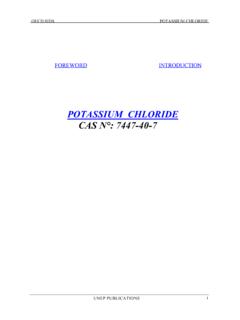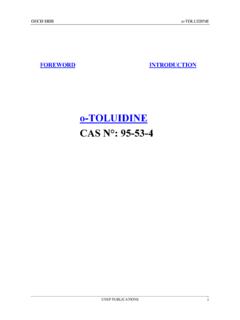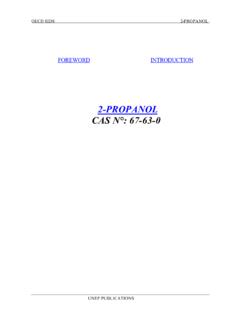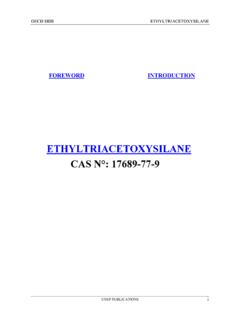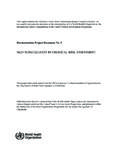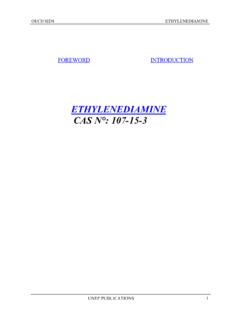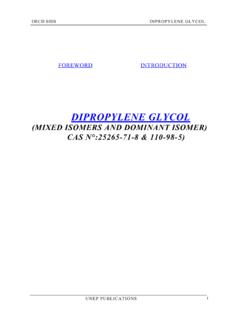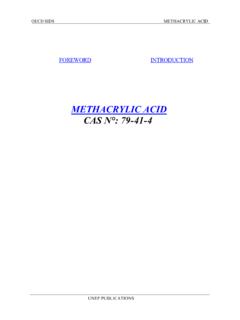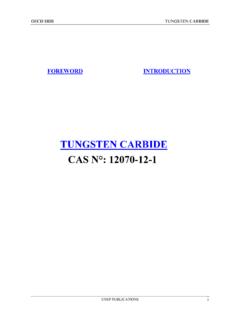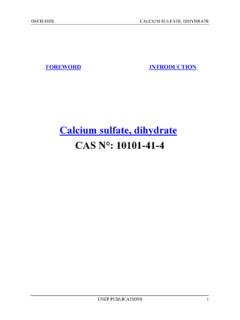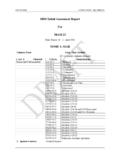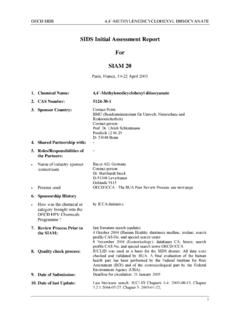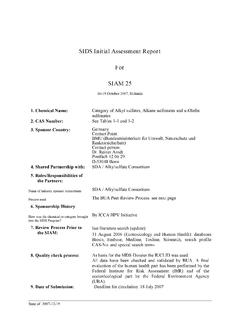Transcription of ISOBUTYLENE CAS N°: 115-11-7 - inchem.org
1 OECD sids ISOBUTYLENE UNEP PUBLICATIONS 1 FOREWORDINTRODUCTION ISOBUTYLENE CAS N : 115-11-7 OECD sids ISOBUTYLENE UNEP PUBLICATIONS 2 sids initial assessment report ForSIAM 17 11-14 November 2003, Arona, Italy 1. Chemical Name: ISOBUTYLENE 2. CAS Number: 115-11-73. Sponsor Country: France4. Shared Partnership with: CEFIC Lower Olefins Sector Group 5. Roles/Responsibilities of the Partners: x Name of industry sponsor /consortium CEFIC Lower Olefins Sector Group/ Christian Gilliard x Process used Documents drafted by ExxonMobil Biomedical Sciences, Inc.
2 Box 971, 1545 Route 22 East Annandale, NJ 08801-0971, USA. Reviewed by LOSG industry toxicologists and by French Competent Authority by reference to published data sources. 6. Sponsorship History x How was the chemical or category brought into the OECD HPV Chemicals Programme ? Industry prepared documents intended for consideration at SIAM 17, initial drafts were submitted February 2003. Data searches were conducted of available literature, databases, and internal consortia files. 7. Review Process Prior to the SIAM: The sids documents were posted on the Pre-SIAM CDG for comments by the other OECD Member countries.
3 Responses to these comments were also posted to the Pre-SIAM CDG. 8. Quality check process: Industry Consortium: Critical biological studies discussed in the SIAR were reviewed for quality by industry and assigned a reliability code, based on the review process guidance of Klimisch et al. (1999). Robust summaries of critical data were added to a sids dossier for ISOBUTYLENE and flagged as "critical", the summary formats for selected endpoints were based on descriptions in the OECD Form and Guidance for preparing and submitting the sids DOSSIER (INCLUDING ROBUST STUDY SUMMARIES),which is from the Manual for Investigation of HPV physicochemcial data from published journals or peer-reviewed databases were added to the dossier in robust summary format.
4 Peer-reviewed databases were not rereviewed. Additional non- sids data in IUCLID that contributed to a more complete understanding of ISOBUTYLENE hazard were discussed in the SIAR, OECD sids ISOBUTYLENE UNEP PUBLICATIONS 3but may not have been reviewed for quality. French Government: French Competent Authority peer-reviewed the sids documents and audited selected key studies to check the robust study summaries. 9. Date of Submission: 31st October 2003 10. Date of last Update: 31st October 2003 11. Comments: OECD sids ISOBUTYLENE UNEP PUBLICATIONS 4 sids initial assessment PROFILECAS Name ISOBUTYLENE Structural Formula CH3|CH2=C-CH3 SUMMARY CONCLUSIONS OF THE SIAR Human Health ISOBUTYLENE has a low order of acute toxicity.
5 As ISOBUTYLENE is a gas at normal temperature and pressure, ingestion or dermal absorption of this material is unlikely. The 2-hour LC50 of ISOBUTYLENE in mice was 180,000 ppm (415 mg/L) and the 4-hour LC50 in rats was 270,000 ppm (620 mg/L). Inhalation of ISOBUTYLENE can produce central nervous system depression, anesthesia and/or asphyxiation. However, these effects are only seen at very high concentrations, , approximately 20% or higher. ISOBUTYLENE is predicted to produce narcosis in humans at concentrations exceeding the lower explosive limit (LEL) of 18,000 ppm.
6 There are no data to evaluate the dermal or ocular irritation potential of ISOBUTYLENE . However, should skin or eye contact occur to this chemical in its liquid state, tissue freezing, severe cold burn, and/or frostbite may result. Repeated dose toxicity clearly demonstrated that ISOBUTYLENE is not toxic to rodents at concentrations up to 8,000 ppm ( mg/L) for 14 weeks. There was a minimal increase in right kidney weights of 4,000 and 8,000 ppm ( and mg/L, respectively) male rats and 8,000 ppm ( mg/L) male mice and the relative (to body weight) right kidney weights of all exposed groups of male rats and 8,000 ppm ( mg/L) male mice were greater than those of the chamber controls.
7 The absolute liver weights of female rats exposed to 1,000 ppm and above, and the relative (to body weight) liver weights of all exposed groups of female rats were greater (up to 20%) than those of the chamber controls. However, the increases in absolute and relative (to body weight) liver weights did not occur in a concentration-related manner. The absolute and relative (to body weight) right kidney weights of all groups of exposed female mice were greater (up to 18%) than those of the chamber controls, but in general, were not exposure concentration related. There were no histopathologic effects associated with increased kidney or liver weights as a result of ISOBUTYLENE exposure.
8 There were no exposure-related gross lesions in the rats. Some minimal hypertrophy of goblet cells lining the nasopharyngeal duct in the most caudal section of the nasal cavity was observed in all groups of exposed male and female rats but not mice. There were no clinical findings or biologically significant effects on male or female reproductive organs attributed to ISOBUTYLENE exposure in rats or mice. The NOAEL was 8,000 ppm ( mg/L). Although ISOBUTYLENE produced an increase in follicular cell carcinomas of the thyroid in male rats exposed for 105 weeks, this was observed only at the highest exposure concentration ( , 8000 ppm) and did not occur in female rats nor male or female mice.
9 Overall, the data suggest that ISOBUTYLENE has a low carcinogenic potential. In addition, the follicular cell carcinomas in the thyroid were reported to be morphologically similar to spontaneously developing follicular cell carcinomas and there was no concurrent increase in the incidence of follicular cell hyperplasia or adenoma in male rats. It should also be noted that there was no evidence of any carcinogenic activity in female rats or mice up to 8000 ppm. Taken in concert, these data suggest that ISOBUTYLENE has a low carcinogenic potential. The NOAEL was 2,000 ppm ( mg/L).
10 Test data clearly demonstrate that ISOBUTYLENE is not mutagenic in a battery of in vitro and in vivo mutagenicity studies. ISOBUTYLENE was not mutagenic when tested in reverse mutation assays conducted in Salmonella typhimurium and Escherischia coli either in the presence or absence of metabolic activation. ISOBUTYLENE did not increase the number of transformed foci in C3H/10T1/2 clone 8 mouse embryo fibroblast cells. There was no evidence of mutagenic activity in mouse lymphoma L5178Y cells either in the presence or absence of metabolic activation.
